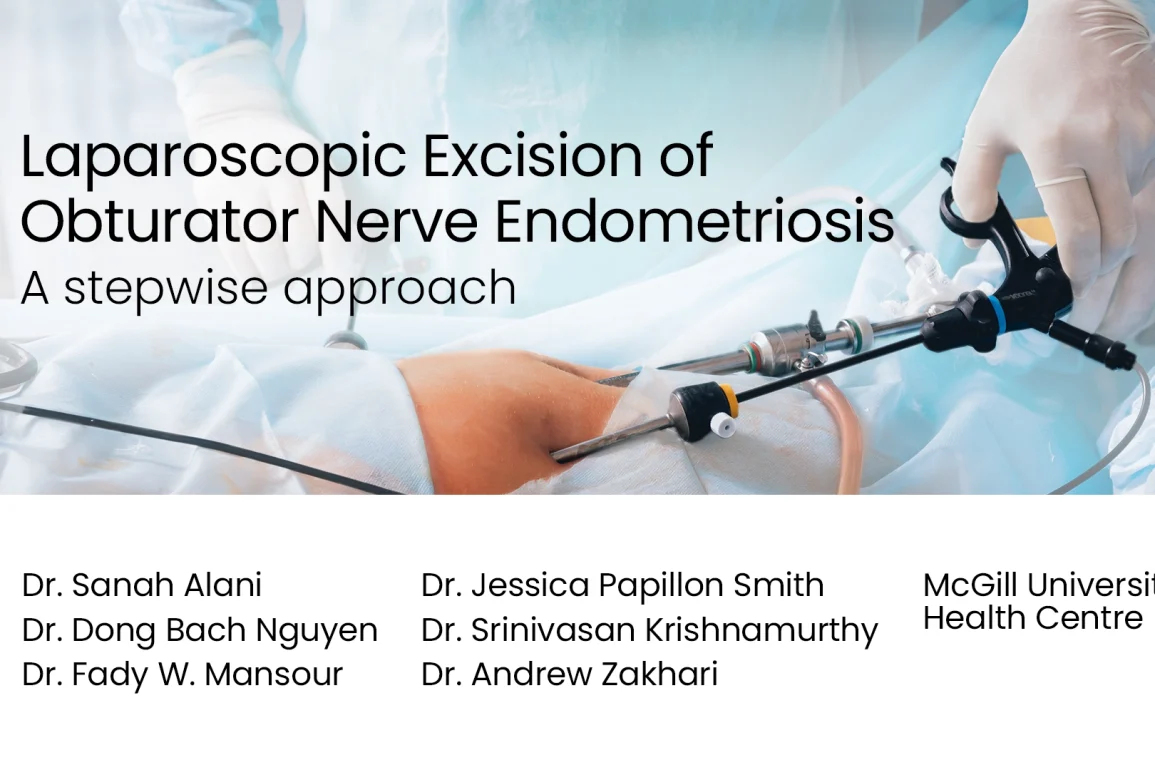Table of Contents
- Procedure Summary
- Authors
- Youtube Video
- What is Laparoscopic excision of obturator nerve endometriosis a stepwise approach?
- What are the Risks of Laparoscopic excision of obturator nerve endometriosis a stepwise approach?
- Video Transcript
Video Description
Step-by-step laparoscopic excision of obturator nerve endometriosis, focusing on anatomy, nerve-sparing dissection, and symptom relief in complex cases.
Presented By
Affiliations
McGill University Health Centre
Watch on YouTube
Click here to watch this video on YouTube.
What is Laparoscopic excision of obturator nerve endometriosis a stepwise approach?
Laparoscopic excision of obturator nerve endometriosis is a nerve-sparing procedure to remove deep infiltrating disease from the obturator nerve and adjacent pelvic sidewall using a defined sequence to protect critical neurovascular structures and restore function. Here’s what it involves:
- Abdominal survey and exposure: Perform a systematic inspection, then mobilize the sigmoid (for left-sided disease) to open the lateral retroperitoneum and optimize access to the pelvic sidewall.
- Iliolumbar space dissection: Enter lateral to the psoas; identify the psoas muscle, external iliac vessels, and the genitofemoral nerve; develop the iliolumbar space to locate the proximal obturator nerve.
- Pararectal (Latzko) space and ureterolysis: Trace the dilated or at-risk ureter caudally, lateralize it safely, and fully develop the lateral pararectal space to expose the medial extent of disease.
- Obturator space dissection: Define the lesion’s borders near the bifurcation of the external/internal iliac vessels; transect the round ligament as needed and open the perivesical plane to complete triangulation of the nodule.
- Nodule release and excision: Skeletonize the obturator nerve; sharply excise the triangular nodule off the nerve with minimal thermal energy, preserving nerve continuity and hemostasis.
- Confirmation and hemostasis: Re-inspect the nerve proximally and distally, verify a dry field, and proceed with any planned concurrent procedures.
This stepwise map leverages pelvic spaces to achieve complete excision while safeguarding the obturator nerve, ureter, and iliac vessels.
What are the Risks of Laparoscopic excision of obturator nerve endometriosis a stepwise approach?
This complex procedure carries important surgical risks that require meticulous technique to minimize.
- Obturator neuropathy: Adductor muscle weakness, thigh numbness, or chronic pain from traction or inadvertent nerve injury.
- Genitofemoral nerve damage: Sensory loss or dysesthesia of the anterior thigh if the superficial branch is injured during iliolumbar dissection.
- Major vascular bleeding: Hemorrhage from the external or internal iliac vessels or obturator vessels during deep pelvic dissection.
- Ureteral or bladder injury: Accidental trauma during pararectal or perivesical dissection.
- Lymphatic complications: Lymphocele or pelvic fluid collection following extensive sidewall dissection.
- Infection or hematoma: Pelvic abscess or postoperative bleeding requiring drainage or reoperation.
- Persistent or recurrent pain: Ongoing symptoms from residual microscopic disease or irreversible nerve damage.
- Anesthetic and thromboembolic events: Increased operative time raises the risk of anesthesia-related complications and deep vein thrombosis.
Careful preoperative imaging, precise identification of pelvic landmarks, and strict nerve-sparing technique are essential to reduce these complications and preserve long-term function.
Video Transcript:
This video demonstrates a stepwise laparoscopic approach to excising endometriosis from the obturator nerve. The obturator nerve arises from the L2/3/4 nerve roots of the lumbar plexus. It travels through the psoas muscle, deep to the common iliac vessels, and exits via the obturator canal. It innervates the medial thigh with both motor and sensory fibres.
Obturator nerve endometriosis is a rare form of deep infiltrating endometriosis, with only a few case reports in the literature. It should be suspected in patients with cyclical leg pain, or paraesthesia, thigh adduction weakness, or difficulty walking. MRI is the imaging modality of choice, and early treatment is essential to avoid chronic neuropathy.
Safe excision of an obturator nerve nodule requires a clear understanding of pelvic spaces. In this side view of the pelvis the obturator nerve can be identified in the iliolumbar space between the psoas muscle and the external iliac vessels. Care should be taken to avoid injuring the genitofemoral nerve. Endometriosis nodules can be identified in the iliolumbar space proximally, obturator space distally, and medially within the lateral pararectal space.
We present the case of a 30-year-old woman known for Stage 4 endometriosis identified on previous laparoscopy, complaining of severe pelvic and leg pain. MRI revealed adenomyosis, a deep rectovaginal nodule, severe hydroureteronephrosis from a ureteric nodule, and a 1.6 cm lesion on the left obturator nerve.
She had failed medical therapy, and was consented to laparoscopic excision of the operator nodule, along with a ureteral reimplantation, and a rectal disc excision. The excision follows six key steps. Abdominal survey, sigmoid mobilisation when operating on the left side, iliolumbar space dissection, pararectal space dissection and ureterolysis, obturator space dissection, nodule release, and excision.
Initial survey of the pelvis reveals stage four endometriosis with a rectovaginal nodule, a dilated left ureter, and evidence of deep disease in the left pelvic sidewall. After ensuring adequate sigmoid mobilisation, the dissection is started lateral to the left infundibula pelvic ligament, to enter the retroperitoneum.
The psoas muscle is readily identified with the genitofemoral nerve coursing superficially along it. Medial traction along this dissection reveals the external iliac vessels, as well as the medialised dilated ureter and ovarian vessels of the left side. The dissection is continued medial to the psoas muscle, and lateral to the external iliac vessels to develop the iliolumbar space. Care is taken to maintain meticulous haemostasis as the dissection is carried deeper.
The external iliac vessels can be medialised to improve visualisation as the proximal obturator nerve is approached. Lateral and medial dissection along the nerve helps delineate its course, as well as identify the proximal margin of the lesion.
After completing this lateral and proximal dissection, attention is drawn towards the medial deeper aspect. The dilated ureter is traced caudally towards the transition point caused by deep infiltrating endometriosis, and the lateral pararectal space, or Latzko space is thus developed.
The round ligament is transected, and the anterior and distal margin of the lesion is delineated along the left round ligament and towards the left perivesical space, as identified by the obliterated umbilical ligament.
The lesion is identified at its proximal and medial limit near the bifurcation of the external and internal iliac vessels. The dissection is carried deeper at this point, until the obturator nerve is identified medially within the obturator space, similar to how obturator lymph nodes are excised in gynae oncology.
At this point the triangular shaped lesion is easily appreciated, extending from the obturator nerve towards the left round ligament of the uterus, and the dilated left ureter. The lesion is then gently excised from the obturator nerve, taking care to avoid thermal injury or trauma.
Here we can see the dissected obturator nerve from the initial iliolumbar space dissection, as well as medially from the obturator space. This medialised lesion is then excised in its entirety, completing this part of the procedure for the patient. The remainder of the surgery was then completed as planned. At six weeks post-op the patient reported resolution of leg pain, and improved pelvic symptoms. Pathology confirmed active glandular endometriosis along the obturator nerve.
Recognising rare forms of deep infiltrating endometriosis is essential, and MRI is a valuable tool for pre-operative planning. Safe complete excision of obturator nerve disease requires an understanding of pelvic spaces, anatomy, and a stepwise surgical approach.




